Shakespeare's Sisters exhibition material
This article relates to the exhibition. For other uses, see Shakespeare's Sisters (disambiguation).
This article offers a comprehensive list of each piece included in Shakespeare's Sisters: Voices of English and European Women Writers, 1500-1700, one of the Exhibitions at the Folger.
The Clifford Women: Patrons, Readers, and Writers (case 1)
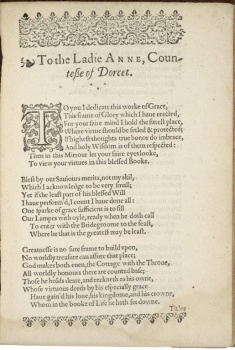
Lady Anne Clifford (1590–1676) was a great reader and a powerful noblewoman who spent much of her life trying to recoup the large properties that she was prevented from inheriting as a woman. She was aided by her mother, Margaret Clifford, countess of Cumberland (1560–1616). This pious and intelligent woman encouraged her daughter’s education by hiring the poet and historian Samuel Daniel as Lady Anne’s tutor. She also gave support and encouragement to Aemilia Lanyer, one of England’s first published women poets. Lanyer remembers her happy time with the Clifford women at the country estate of Cookham, “where many a learned Booke was read and skand.” Lady Anne kept a detailed diary through much of her life, and collected a large library.
The collection of items in Case 1 contained works with dedicatory poems to both Clifford women, as well as a book owned and read by Lady Anne.
Aemilia Lanyer's Salve Deus Rex Judæorum is dedicated to a group of women who supported writers, which included both Lady Anne and her mother, Margaret Clifford; Lucy, countess of Bedford; and Mary Sidney, countess of Pembroke, herself a poet. The central portion of Aemilia Lanyer’s work, “Hail God King of the Jews,” is a religious poem in which she comments on Christ’s passion from a woman’s point of view, focusing on Pilate’s wife and on a defense of Eve. This was a bold move on Lanyer’s part, since women were not encouraged to interpret scripture at all. Lanyer also included a poem at the end titled “The Description of Cooke-ham,” an early country-house poem telling of her days at the Clifford estate.
Samuel Daniel’s moralistic poem to his student, Lady Anne Clifford, praises her innocent virtue and says that her mother who gave her being, also
… labour[s] to adorne
That better part, the mansion of your minde,
With all the richest furniture of worth,
To make y’as highly good as highly borne.
Daniel probably began tutoring Lady Anne by the time she was eight or nine, and she included his portrait in the “Great Picture” of her family which she later commissioned.
Also shown was Lady Anne's own copy of John Selden’s Titles of Honor, on which she wrote “I began, to overlook this Book the 18 of February and I did make an end of reading, or over looking it all over the first of March following 1638.” The book interested her because it deals with the inheritance of land and titles. She spent much of her life collecting ancient documents to prove her right to inherit her mother’s property in the north of England. In the process she became the first great female antiquarian.
Items included
- Amelia Lanyer. Salve Rex Judaeorum. London: Printed by Valentine Simmes for Richard Bonian, 1611. STC 15227 copy 1; displayed E4r.
- FACSIMILE from Skipton Castle, Yorkshire. English School. Portrait of Lady Anne Clifford. Oil on panel, 17th-century.
- FACSIMILE from Skipton Castle, Yorkshire. English School. Portrait of Lady Margaret Clifford. Oil on panel, 17th-century.
- Amelia Lanyer. Salve Rex Judaeorum. London: Printed by Valentine Simmes for Richard Bonian, 1611. STC 15227 copy 2; displayed E1r.
- Samuel Daniel. The whole workes of Samuel Daniel Esquire in poetrie. London: Printed by Nicholas Okes, for Simon Waterson, 1623. STC 6238 copy 1; displayed p. 71 inscription.
- John Seldon. Titles of honor. London: Printed by William Stansby for Richard Whitakers, 1631. STC 22178 copy 3; displayed title page inscription.
- LOAN from the Library of Congress. Virginia Woolf. Second Common Readers. New York: Harcourt, Brace, and Company, 1932. PR99 .W78 1932a; displayed essay on Donne after three centuries.
Portrait of Elizabeth Cary (wall between cases 1 and 2)
- FACSIMILE from the Sarah Campbell Blaffer Foundation, Houston, Texas. Paul van Somer. Portrait of Elizabeth Cary, 1st Viscountess Falkland. Oil on canvas, ca. 1620.
English Translations of French Religious Works (case 2)
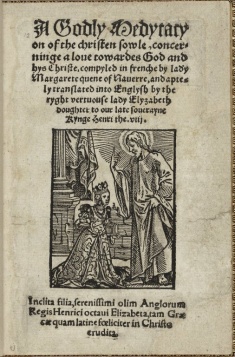
Many aristocratic Englishwomen could read French, and were especially attracted to religious writings. Religion was a central part of daily life at a time when the Protestant church was relatively new in England and France, competing with the older Catholic tradition. Writing prayers and translating religious texts was an acceptable way for women to make their private voices heard publicly. Elizabeth I studied French, and, at the age of eleven, translated A Godly Meditation of the Christian Soul from the French of Marguerite de Navarre. Mary Sidney, countess of Pembroke, rendered Philippe de Mornay’s Discourse of Life and Death into English in 1592, and shortly thereafter, Baroness Elizabeth Richardson made her own abridgement and revision of Sidney’s translation in her commonplace book. The 1630 translation by Elizabeth Cary, viscountess Falkland of Jacques du Perron’s Reply . . . to the Answer of the most Excellent King of Great Britain provided an important voice for English Catholics in their ongoing debate with Protestants.
At the age of eleven, Princess Elizabeth, later Queen Elizabeth I, translated Marguerite de Navarre's A Godly Meditation of the Christian Soul for her stepmother, Queen Katherine Parr, as a 1545 New Year’s gift. Protestant reformer John Bale edited the work and had it published three years later in Germany, when Elizabeth was just fifteen. In the original manuscript, Elizabeth points out how the book feminizes the relationship between the individual soul and God, describing how “she [the soul] doth perceive how of herself . . . she can do nothing . . . unless it be through the grace of God, whose mother, daughter, sister, and wife by the Scriptures she proveth herself to be.”
Mary Sidney translated Philippe de Mornay's Discourse of Life and Death in 1592. Mornay was a leader of the French Huguenots and a close friend of the Sidney family, who were strong supporters of the Protestant cause. In the early seventeenth century, Elizabeth Ashburnham Richardson summarized Mary Sidney’s translation of Mornay and meditated on several points. She reduced the original thirty-one printed pages to four, with her own introduction and conclusion. Shown here are her manuscript and her signature.
Items included
- FACSIMILE the Royal Collection, by gracious permission of Her Majesty, Queen Elizabeth II. Portrait of Queen Elizabeth I. Watercolor on vellum attached to a playing card. Attributed to Levina Teerlinc, ca. 1560-5.
- Marguerite de Navarre. A godly medytacyon of the christen sowle.Translated by Elizabeth I, Queen of England. Wesel: Dirik van der Straten, 1548. STC 17320; displayed title page.
- FACSIMILE from Musée Condé, France. Attributed to François Clouet and Jean Clouet. Portrait of Marguerite d’Angoulême, Queen of Navarre. Oil on wood panel,ca. 1540.
- Mornay, Philippe de, seigneur du Plessis-Marly. A discourse of life and death. Translated by Mary Sidney, Countess of Pembroke. London: Printed by John Windet for William Ponsonby, 1592. STC 18138; displayed title page.
- LOAN from the Beinecke Library, Yale University. Elizabeth Cary. Reply of the most illustrious Cardinal of Perron. Douay: Martin Bogart, 1630. Me65 D925+R4G; displayed dedication to Henrietta Maria.
- Elizabeth Richardson, Baroness Cramond. “A discourse of ye teadiousness of life and profitt of death” from Instructions for my children. Manuscript, 1606. V.a.511; displayed fol. 84 with facsimile of Elizabeth Ashburnham’s signature.
Mary Sidney's Psalms (wall panel between cases 2 and 3)
- FACSIMILE from National Portrait Gallery, London. Nicholas Hilliard. Portrait of Mary Sidney Herbert, countess of Pembroke. Watercolor on vellum, ca. 1590.
- FACSIMILE images from Bodleian Library, Oxford University. Mary Sidney. The Psalmes of David translated into divers and sundry kindes of verse. Manuscript, ca. 1620–30. Bodl. MS. Rawl. poet. 24.
Versifying the Psalms (case 3)
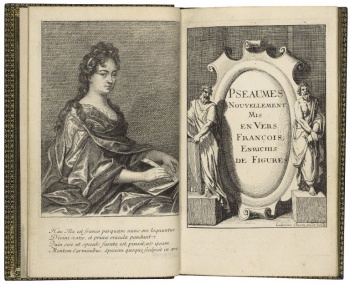
The Psalms were a form of religious verse from the Old Testament that was attractive to Protestant and Catholic readers alike in different countries. A number of women writers found comfort and inspiration in composing their own versions in a variety of verse forms. The seven Penitential Psalms asking God for mercy were especially popular. They are usually the Psalms numbered 6, 31, 37, 50, 101, 129 and 142 in the Vulgate version. Working with the Psalms also provided an opportunity for women to have a political voice. Esther Inglis made some of her calligraphic masterpieces for supporters of the English Protestant cause, while Laura Battiferri, a major patron of the Jesuits, dedicated her Penitential Psalms to Vittoria Farnese Della Rovere, granddaughter of Pope Paul III, who convened the Council of Trent, leading to reforms in the Catholic Church.
The book by John Calvin displayed was translated by Ann Locke Prowse who was active in the early Calvinist movement in England. A friend of preacher John Knox, she visited the Protestant stronghold of Geneva and translated both this work and one by a student of Calvin, Jean Taffin. Her sequence of twenty-one sonnets meditating on Psalm 51 was printed at the back of her translation of Calvin’s Sermons on Isaiah. She prays for God to give her a voice:
Lord loose my lippes, I may expresse my mone,
And findyng grace with open mouth I may
Thy mercies praise, and holy name display.
Laura Battiferri also translated the Psalms. She was already recognized as a major poet — a new Sappho — and was connected with the court circles in Florence, and the whole book is dedicated to the pious Vittoria Della Rovere, duchess of Urbino. Battiferri writes to the duchess: “I have set out to translate his [David’s] penitential songs into Tuscan rhymes, with no other purpose than to pray that it please the Divine Bounty to support this hand and open these lips….”† Each individual Psalm is dedicated to a cloistered nun in Florence or Urbino. The dedicatee of Psalm 51 is Sister Vincentia Biliotti in Florence.
Thomas Bentley's Monument of Matrones includes Morning and Evening Praiers, with Divers Psalms, a book of prayers and Psalms translated by Lady Elizabeth Tyrwhit, one of Queen Katherine Parr’s ladies-in-waiting. Tyrwhit was part of a small group of women at court who shared the queen’s interest in Lutheran-influenced devotional reform. Tyrwhit’s book was first published in 1574, but only one copy of that edition survives.
Other women, like Esther Inglis and Sophie Chéron, translated Psalms and meditated further on them by decorating their books with calligraphy and illustration. Inglis was a skilled calligrapher and she created many manuscripts on religious themes that she gave to English and French courtiers active in the Protestant cause. The embroidered manuscript above displayed is a version of the Psalms (from the French Geneva Bible) full of her intricate calligraphy. It was a gift to Prince Henry, son of King James I. Sophie Chéron's book of Psalms is printed, but is also decorated with engravings. She believed people were inspired by the stories of the Psalms represented in pictures. Although she was herself a gifted painter, poet, and musician, the illustrations in this book were done by her brother.
- † (Translation by Victoria Kirkham)
Items included
- Ann Locke Prowse. A Meditation of a Penitent Sinner. London: John Day, 1560. STC 4450; displayed Aa3v - Aa4.
- Laura Battiferri degli Ammannati. I sette salmi penitentiali del santissimo profeta Dauit. Fiorenza: Appresso i Giunti, 1566. 252- 285q; displayed p. 22-23 p. 22-23 with facsimile of title page.
- Esther Inglis. Les CL pseaumes de David escrites en diverses sortes de lettres par Esther Anglois, Françoise, Lislebourg. Manuscript, 1599. V.a.93; displayed closed.
- Esther Inglis. Argumenta psalmorum Davidis per tetrasticha manu Estherae Inglis exarata strenae nomine illus. Manuscript, 1608. V.a.94; displayed closed. Seed pearl binding.
- Elisabeth Sophie Chéron. Pseaumes de David et Cantiques. Paris: Chez Guillaume de Luyne, Michel Brunet, Charles Robustel et M. Cheron, 1694. 240- 744q; displayed frontis and title page.
- Thomas Bentley. The monument of matrones. London: H. Denham, 1582. STC 1892 copy 2; displayed p. 103.
Decorating the Psalms (wall panel above case 3)
- FACSIMILE of Esther Inglis. Les CL pseaumes de David escrites en diverses sortes de lettres par Esther Anglois, Françoise, Lislebourg. Manuscript, 1599. V.a.93; illustration for emblem indicating that the written word outlives all monuments.
- FACSIMILE of Esther Inglis. Argumenta psalmorum Davidis per tetrasticha manu Estherae Inglis exarata strenae nomine illus. Manuscript, 1608. V.a.94; title page with floral border and dedication to Henry, Prince of Wales.
- FACSIMILE of Elisabeth Sophie Chéron. Pseaumes de David et Cantiques. Paris: Chez Guillaume de Luyne, Michel Brunet, Charles Robustel et M. Cheron, 1694. 240- 744q; illustrations to Psalm 8 and Psalm 76.
Georgette de Montenay's Emblems (wall panel between cases 3 and 4)
- FACSIMILES of Emblem I and Emblem LI from Georgette de Montenay. Liure d’armoiries en signe de fraternite contenant cent comparaisons de vertus et emblemes Chrestiens agences. Frankfurt: Jean Charles Unckel, 1619. STC 18044.8.
Varieties of Religious Writing (case 4)
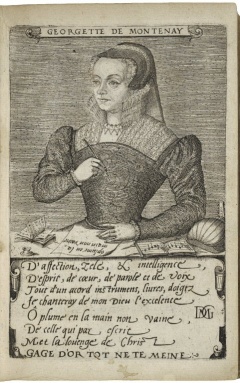
Women practiced many kinds of religious writing in addition to translating Psalms. Their work—among Protestants, Catholics, and splinter groups—ranges from private meditations and sermons to prophecy, polemics, and didacticism. Katherine Parr, Vittoria Colonna, and Marguerite de Navarre revealed a deeply personal spirituality in their verses, while Eleanor Douglas was led to prophesy publicly. The Quaker Margaret Fell defended women’s right to speak in public about religious matters. Georgette de Montenay expressed her Protestant beliefs by creating a book of Christian emblems. Religious writing provided a major outlet for self-expression among women, whose piety set an example within their own households and in their religious groups.
Queen Katherine Parr's Prayers or meditacions was influenced by Marguerite de Navarre’s Mirror of the Sinful Soul, a text which her stepdaughter, the future Queen Elizabeth I, had presented to her. Katherine was the sixth wife of Henry VIII, highly educated, and served as an intelligent companion to the aging king. Her book was written around 1546/7 but published after the death of Henry VIII, probably because of its Lutheran and more radical Protestant leanings.
Other religious writing took the form of emblems, such as those by Georgette de Montenay. The emblem is a literary form that reveals its message through a combination of image, motto, and poem. Montenay created the first emblem book used for religious propaganda, in support of the Calvinist faith. Her book was republished many times in several languages. In the frontispiece portrait, de Montenay is depicted as a writer with pen, ink, and paper.
Another writer, Vittoria Colonna, is known mainly for her secular love poetry and her friendship with Michelangelo, but in her later life, she turned to spiritual poetry in which she expresses love for Christ. She writes:
He is the author of peace, rest from war,
Quiet is found in him. †
She was influenced in her religious thinking by the English cardinal Reginald Pole, who resided in Italy and became her mentor.
Although most women had never been encouraged to preach openly by established churches, Quakers believed that because men and women could equally receive God’s spirit, both could preach. Margaret Fell, married to Quaker founder George Fox, justified women’s claim to speaking by looking at biblical women who testify to the truth. As examples, she cites Mary Magdalene and Mary the mother of James who followed Jesus, as well as women in the early Christian church, mentioned in the book of Acts.
Also shown were the tracts of Eleanor Davies, a well-educated woman who, in 1625, had a vision of the Day of Judgment. She associated herself with the Old Testament prophet Daniel and began writing and publishing many prophetic tracts. A number of them were kept and bound together by her daughter, Lucy Huntingdon, in The bill of excommunication for abolishing henceforth the Sabbath. Many of the tracts show Davies’ own annotations in preparation for the publication of corrected versions. She denounced Charles I, supported Oliver Cromwell, and believed that the end of the world was at hand.
- † (Translation by Ellen Moody)
Items included
- Catherine Parr. Prayers or meditacions, wherein the minde is stirred. London: W. Powell, ca. 1550. STC 4824a; displayed title page.
- Vittoria Colonna. Rime. Venegia: Appresse Gabriel Giolito de’ Ferrari, 1559. PQ4620 C96 R5 1559 Cage; displayed p. 79.
- LOAN from Lisa Baskin. Marguerite de Navarre. Marguerites. Lyons: Pierre de Tours, 1549. Displayed title page.
- Abraham Bosse. Les vierges sages. Paris: Le Blond, ca. 1640. Art Box B745 no.6 (size L) Image of Art Box B745 no. 6 (size L).
- Georgette de Montenay. Liure d’armoiries en signe de fraternite contenant cent comparaisons de vertus et emblemes Chrestiens agences. Frankfurt: Jean Charles Unckel, 1619. STC 18044.8; displayed portrait after p. 8.
- Eleanor Douglas. The bill of excommunication, for abolishing henceforth the Sabbath called Sunday or first day. London: [s.n.], 1649. D1979 Bd.w. D2010; displayed title page of D1979 with [1] of daughter's signature at front of book.
- Margaret Fell. Womens speaking justified. London: [s.n.], 1666. F642 copy 1; displayed title page.
Portrait of Princess Marguerite of Angoulême (virtine after case 4)
- FACSIMILE from the Walker Art Gallery, National Museums Liverpool. Jean Clouet. Portrait of Princess Marguerite of Angoulême. Oil on panel, ca. 1530.
Continental Women Writing About Love (case 5)
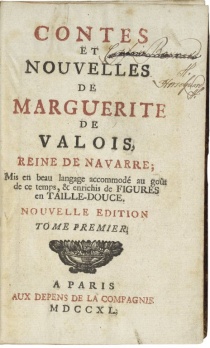
While religious themes dominated early modern women’s writing in England, women in Italy and France wrote about secular love as well. Some, such as Vittoria Colonna, Gaspara Stampa, and Louise Labé used the imagery of Petrarch’s sonnets to speak of their own loves from a female point of view. Veronica Franco drew on the more overtly sexual tradition of Pietro Aretino and Latin verse to compose her sensual poetry. Tullia d’Aragona’s dialogue about the nature of love responded to neo-Platonic writings such as Castiglione’s The Courtier, while Marguerite de Navarre’s Heptaméron used linked stories modeled on Boccaccio’s Decameron to explore many types of love. All of these writers brought fresh perspectives to the dominant male traditions of love literature.
Although both Marguerite de Navarre and Vittoria Colonna wrote religious works, they were both well known for their secular writing about love. In an early portrait of Marguerite, before she became queen of Navarre, she is pictured with a parrot, which may represent eloquence and love, both symbols appropriate for the author of the Heptaméron. This collection of love stories was gathered together and first published in 1559 after Marguerite's death. Influenced by the poet Giovanni Boccaccio’s Decameron, Marguerite created a framing tale of a group of French nobles who are stranded on their way home from a spa. To pass the time, they tell stories, most dealing with various relationships between the sexes.
For her part, Vittoria Colonna was the first major poet to use Petrarchan love imagery from a female point of view. Her poems express longing and mourning for her husband, the soldier Francesco Ferrante d’Avalos, who died in 1525. Her poems circulated widely during her lifetime, and she gave a manuscript copy of her sonnets to her friend, Michelangelo.
Another Italian poet was Tullia d’Aragona, a high-class courtesan who moved in elite literary circles with writers such as Tasso and Aretino. Her Dialogue on the Infinity of Love is set in her own home, and imagines her debating the nature of love with her friend, poet Benedetto Varchi. She creates a complex persona, sometimes playing dumb or submissive, other times smart or arrogant, in an intellectual neo-Platonic game.
Gaspara Stampa's 311 poems were partly inspired by her unhappy love affair with Count Collaltino di Collalto. She also uses Petrarchan imagary of the cruel, disdainful dark lady, later also used by Shakespeare, but she inverts it to refer to her male lover. In the first poem she hopes other women will envy her for loving such a man. Stampa was educated in Latin and Greek and was a talented musician as well.
Like many of the women writing during this period, Lady Anne Southwell wrote both secular and religious works, and her manuscript miscellany contains both, as well as a list of books, receipts, and letters. It was compiled and written by various members of Southwell's household.
Items included
- Vittoria Colonna. Rime della diuina Vettoria Colonna marchesana di Pescara. Venice: Marco Salvioni, 1539. 230- 717q; displayed B8v.
- Tullia d’Aragona. Dialogo della signora Tullia d’Aragona della infinità di amore. Vinegia: Appresso Gabriel Giolito de Ferrari, et fratelli, 1552. PQ4562 A9 D5 Cage; displayed title page.
- Gaspara Stampa. Rime. Venetia: Plinio Pietrasanta, 1554. PQ4634 S65 R5 1554 Cage; displayed A1r.
- LOAN from Houghton Library, Harvard University. Louise Labe. Oeuvres. Lyon: [s.n.], 1555. FC5 L1125 555o; displayed title page.
- LOAN from the Annenberg Rare Book and Manuscript Library, University of Pennsylvania. Veronica Franco. Terze Rime. 1575. PQ4623.F6 T4 1575; displayed Capitolo 16.
- Marguerite de Navarre. Contes et nouvelles. Paris: Aux depens de la Compagnie, 1740. 176- 725q; displayed title page.
Women Poets (wall panel above case 5)
- FACSIMILE from the Uffizi Gallery, Florence, Italy. Christofano dell’Altissimo. Portrait of Vittoria Colonna. Oil on panel, ca. 1550.
- FACSIMILE from Art Resource. Daniel Antonio Bertoli after Guercino. Portrait of Gaspara Stampa. Engraving, 1738.
- FACSIMILE from Art Resource. Pierre Woeiriot. Portrait of Louise Labé. Engraving, 1555.
- FACSIMILE from the Worcester Art Museum, Worcester, Massachusetts. Follower of Jacopo Tintoretto. Portrait of Veronica Franco. Oil on canvas, ca. 1575.
- FACSIMILE from the Pinacoteca Civica, Brescia, Italy. Moretto da Brescia. Portrait of Tullia d’Aragona dressed as Salome. Oil on canvas, ca. 1525–49.
Miscellany of Lady Anne Southwell (vitrine after case 5)
- Lady Anne Southwell. Miscellany of Lady Anne Southwell. Manuscript, ca. 1587-1636. V.b.198; displayed 56v-57r.
Italian Heroic Romance (case 6)

Knights, ladies, and battles were the subjects of popular romances in prose or verse that were largely directed to a female audience. Ludovico Ariosto’s Orlando Furioso (1516) and Torquato Tasso’s Gerusalemme Liberata (1581) were two Italian romances that had wide influence at home and abroad. Drawing on stories of King Arthur, Charlemagne, and other historical events, both works inspired Italian women writers to engage with the romance tradition in different ways. Following Ariosto, Laura Terracina wrote a moral commentary on Orlando Furioso, while Moderata Fonte created a female knight in her own poetic romance. Inspired by Tasso, Margherita Sarrocchi and Lucrezia Marinella wrote heroic epics drawing on historical figures from the Ottoman wars in the thirteenth and fifeenth centuries.
First published in 1581, Torquato Tasso's Jerusalem Liberated is an epic poem in twenty cantos. It celebrates the feats of Godfrey of Bouillon, who led the First Crusade in which Christians defeated the Turks at Jerusalem in 1099. The struggle between east and west was a “hot” topic in Tasso’s time when the Ottoman Empire was threatening Europe. Over half a century earlier, Ludovico Ariosto penned his famous poetic romance about the chivalric knight Orlando (or Roland) in 1516. While detailing the knight’s futile search for his lady-love Angelica, the poem also recounts the medieval struggle between Christians and Muslims. The Folger copy is special edition printed on blue paper with gold decoration is illustrated with fine woodcuts.
These two heroic romances serve as the basis for several works on view, including the first heroic epic by a woman, written by Margherita Sarrocchi. It tells of the feats of an Albanian warrior, George Scanderbeg, against the Ottomans in the fifteenth century. It is dedicated to Giulia d’Este, daughter of the duke of Modena. One of the most learned women of her time, Sarrocchi corresponded with Galileo and Tasso, wrote Latin poems and lectured on philosophy. Her decision to write an heroic epic in the style of Tasso’s Gerusalemme, considered the highest example of that poetic form, shows her intellectual self-confidence.
Using the same heroic romance tradition, Laura Terracina produced a 42-canto poem linked to Ariosto’s epic. A prolific Neapolitan poet, and member of an elite literary academy, Terracina's work was especially popular. Rather than telling a discrete story, it provides moral commentary, using the first octave of each canto in Ariosto’s Orlando Furioso. Terracina strongly encourages women to make their own voices heard by reading and writing. Addressing male writers she says:
Oh if only women would give up the needle,
the thread and cloth, and take on the burden of study
I think they would give you writers great difficulties. †
Also following the tradition of Ariosto’s chivalric romance is Moderata Fonte’s Thirteen Songs. It follows the adventures of the beautiful female knight, Risamante, who searches for her inheritance. Fonte argues for the equality of women and men:
Women of every age have been endowed by Nature
with great judgment and spirit
nor are they less apt in revealing with attentive study
the same wisdom and courage with which men are born. ††
- † Canto 37, Translation
- †† Translation by Irma Jaffe and Gernan
Items included
- Laura Terracina. La prima parte de’discorsi sopra le prime stanze de’canti d’Orlando furioso. Venetia: Per gli heredi di Luigi Valuassori, & Giouan Domenico Micheli, 1584. 168- 765q v.1; displayed author portrait.
- Moderata Fonte. Tredici canti del Floridoro. Venetia: Francesco Rampazetto, 1581. 183- 328q; displayed A1r.
- Margherita Sarrocchi. La Scanderbeide : poema heroico. Roma: Lepido Facij, 1606. 252- 745f; displayed title page.
- LOAN from Houghton Library, Harvard University. Lucrezia Marinella. L’Enrico. Venice: Imberti, 1635. IC6 M3386 635e; displayed title page.
- Lodovico Ariosto. Orlando Furioso. Venetia: Appresso Gabriel Gioli di Ferrarii, 1544. PQ4567 A2 1544 Cage; displayed leaf 16.
- Torquato Tasso. La Gerusalemme liberata. Venetia: Dal Sarzina, 1625. 177- 100q; displayed p. 177.
Women Reading Sidney's Arcadia (wall between 6 and 7)
- Wall Panel: “Women Reading Sidney’s ‘Arcadia’” with quotes from Lady Anne Clifford’s Diary and Virginia Woolf’s The Common Reader, Second Series
- Edward Hall. The vnion of the two noble and illustrate famelies of Lancastre and Yorke. London: Richardi Graftoni, 1548. STC 12721 copy 2; displayed Mary Sidney verse and signature after Fol. cclx (26), before Fol. F.
Sidney Family Ties (case 7)
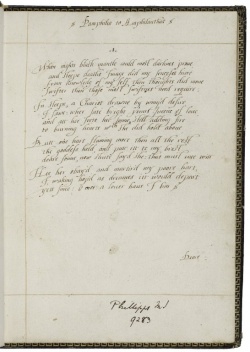
The Sidneys were one of the most literary families in Tudor and Stuart England. The matriarch, Mary Dudley Sidney, knew several languages and was a great letter writer. Her son, Sir Philip Sidney, wrote a sonnet sequence and composed the prose romance Arcadia, based on Ariosto, for his sister, Lady Mary Sidney. After Philip’ early death in 1586, Mary Sidney completed her brother’ work, and it was published as The Countess of Pembroke’s Arcadia. In the next generation, their niece, Lady Mary Sidney Wroth, wrote her own sonnet sequence and the prose romance Urania. Thus they carried on the Italian heroic romance tradition in England, and inspired other writers such as Anna Weamys, who composed her own Continuation of the Arcadia in 1651, indicating the work’s continued popularity.
In dedicating the Arcadia to his sister, Mary Sidney, countess of Pembroke, Philip Sidney says it is the work of his youth, written “most of it in your presence, the rest, by sheetes, sent unto you, as fast as they were done.” Sidney left the work incomplete, and after his early death, Mary Sidney took over the complicated editorial work of arranging the manuscript versions he had left into the revised edition on exhibit. It is credited in the introduction as being “most by her doing, all by her directing.” The Folger's copy was owned by Dorothy Wylde, who wrote her name and the date 1645 across from the dedication to Mary Sidney.
Philip Sidney's niece, Lady Mary Wroth, wrote two of the items on display: the Urania and the sonnet sequence Pamphilia to Amphilanthus. In 107 sonnets and songs, Pamphilia to Amphilanthus develops the theme of Pamphilia’s unrequited love for Amphilanthus, reversing Petrarchan motifs, as Italian women writers had done, to make the beloved a man. Like the poetry of her uncle, Wroth’s poems first circulated in manuscript among her friends, and the copy on display is the only known manuscript of Mary Wroth’s sonnet sequence in her own hand. Some of Wroth's poems were later published with her prose romance, Urania, the first romance written by a woman in English. It also examines Pamphilia’s frustrated love for the unfaithful Amphilanthus. Lady Mary Wroth wrote a second volume, but it was not published at the time because characters and events in Urania were seen as too close to real life for the noble families involved. Certainly, part of the story suggests Wroth’s own involvement with her cousin, William Herbert, with whom she had two children out of wedlock.
Although not related to the Sidneys, Anna Weamys was influenced by Philip Sidney's writing and wrote a sequel to the Arcadia in which she rewrites some of Sidney’s plot and finishes several of the unresolved love stories by marrying off the couples. Like Mary Wroth, she was especially drawn to the character of Urania, but the two women writers treat her differently. Wroth’s Urania tends to be an agent of action in others, while Weamys’ Urania is acted upon, a victim of her parents’ authority and of male desire. As a royalist, Weamys used the romance genre to write about courtly virtues at a time when the English royal family of Charles I was in exile.
Items included
- Mary Wroth. Pamphilia to Amphilanthus. Manuscript, ca. 1615-ca. 1620. V.a.104; displayed fol. 1.
- Anna Waemys. A continuation of Sir Philip Sydney’s Arcadia. London: William Bentley, 1651. 166- 792q; displayed title page.
- FACSIMILE by kind permission of Viscount De L’Isle from his private collection. Marcus Gheeraerts the Younger. Double portrait of Two Ladies (probably) Lady Mary Wroth and Lady Barbara Sidney, the landscape with Haymakers. Oil on panel, 1612.
- Mary Wroth. The Countesse of Mountgomeries Urania. London: Augustine Matthews?, 1621. STC 26051 copy 1; displayed engraved title page.
- Philip Sidney. The Countesse of Pembrokes Arcadia. London: John Windet for William Ponsonbie, 1593. STC 22540 copy 1; displayed prelim 3 facing Dorothy Wylde inscription.
The Sidney and Clifford Families (wall panel after case 7)
Family tree and description of the two families
The Great Picture (west wend of hall)
- Jan Van Belcamp. The Great Picture. 1646. Courtesy of Abbot Hall.
Writings By Mothers, Daughters, & Sisters (case 8)
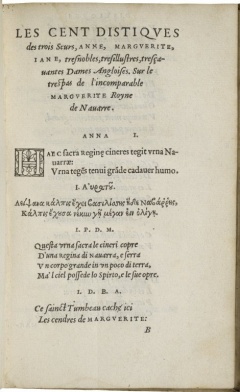
Just as the Sidney and Clifford families created literary circles, so did other families in England and France. Support from one’s family was especially important for women writers who were educated at home and often expected to fulfill household duties before intellectual pursuits. The Seymour sisters in England wrote verses in Latin on the death of Marguerite de Navarre, which were published in France. Two mother-daughter pairs, the Des Roches, and the Deshoulières, wrote poetry together, and the Des Roches hosted a literary circle in their Poitiers home. Later in the seventeenth century, the Mancini sisters each broke away from their husbands, traveled, and wrote memoirs of their colorful lives. They lived on the edge of scandal, pushing the boundaries of women beyond the home.
Both Marie and Hortense Mancini led interesting lives, and both of them wrote memoirs detailing their adventures. Hortense Mancini fled from her husband, and she spent much of her married life traveling across Europe. Her sister Marie also fled from her husband, and for some time, the two traveled together. Hortense eventually settled in London where she became a patron of the arts and was supported by Charles II. Aphra Behn dedicated one of her plays to the duchess, and Susanna Centlivre’s play The Basset-table was inspired by Mancini’s gambling and literary salon. Because the rather scandalous lives of these sisters were so popular, other writers rushed fictional memoirs into print that were attributed to them. The book on display was one of those false memoirs of Marie Mancini using the same imprint as her sister’s book to make it look legitimate.
Less scandalous were the Seymour sisters, daughters of Edward Seymour, duke of Somerset, and lord protector for the young Edward VI. They received a full humanist education and went on to write a tour-de-force poem of 103 Latin couplets composed in memory of Marguerite de Navarre. Their French tutor took the manuscript to France where it was published with congratulatory poems by a number of male Humanists, including the poet Ronsard.
The mother-and-daughter pair, Madeleine and Catherine Des Roches, were learned women from Poitiers, France who held literary salons at their home and whose fame spread to Paris. Both wrote poetry, and Catherine’s works include a sonnet sequence and political poems. Their last publication, on display, contains ninety-six letters to friends and family, some of which extol female friendship and learning. It opens with an epistle from mother to daughter in which Madeleine credits her daughter’s encouragement with her own decision to “speak in public”; that is, allow her writings to be published along with those of her daughter. They both died of the plague the following year, 1587.
For an engaging Question and Answer session with Elizabeth Goldsmith and video about the Mancini Sisters, please read the article The Mancini Sisters: Mistresses and Memoirists.
Items included
- Hortense Mancini, duchess de Mazarin. Memoires de Madame la Duchesse de Mazarin. Cologne: Chez Pierre du Marteau, 1675. DC130 M28 A3 Cage; displayed title page.
- FACSIMILE from the Royal Collection, by gracious permission of Her Majesty, Queen Elizabeth II. Ferdinand Voet. Portrait of Hortense Mancini and her sister, Marie Mancini. Oil on canvas, ca. 1670-1700.
- Marie Mancini. Les memoires. Cologne: Chez Pierre du Marteau, 1675. DC130 C61 M4 1676 Cage; displayed title page.
- Anne Seymour, Jane Seymour, and Margaret Seymour. Le tombeau de Marguerite de Valois royne de Nauarre. Paris: De l’imprimerie de Michel Fezandat, & Robert Granlon, 1551. DC112.M2 U7 Cage; displayed B1r.
- Madeleine des Roches. Les missiues de Mes-Dames Des Roches de Poitiers mere et fille. Paris: Chez Abel l’Angelier, 1586. 165- 546q; displayed Biiir.
- Madame (Antoinette) Deshoulières. Poesies. Paris: Chez la Veuve de Sebastien Mabre-Cramoisy, 1688. 217- 493q; displayed p. 39.
- FACSIMILE from Musée Condé, Chantilly, France. Elisabeth Sophie Chéron. Portrait of Madame Deshoulières. Oil on canvas, 17th century.
- LOAN from the Library of Congress. Madame (Antoinette) Deshoulières. Poesies. Paris: [s.n.], 1705. PQ1794 D4 1705 Pre-1801 Coll, vol. 1; displayed title page.
Women of the French Salons (case 9)
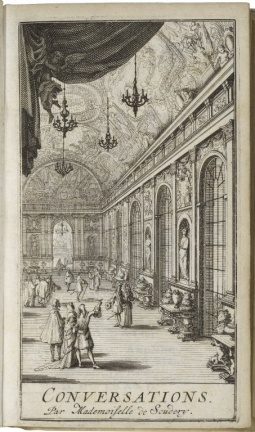
In seventeenth-century France, upper class, educated women opened their homes to male and female intellectuals for elevated conversation and the exchange of ideas. Often the hostess set the agenda for these gatherings, which rose to prominence during the reign of Louis XIV and became important sites for trying out new literary pieces and setting literary standards. Though all of the women represented in this case participated in the salons, Madame de La Fayette and Mademoiselle de Scudéry were particularly outspoken in their literary judgments. Many of their works were soon translated into English for a new and devoted audience.
Abraham Bosse's print depicts a group of women who meet together over good conversation and food while their husbands are away. The elaborate chamber with richly curtained bed and patterned wall covering, as well as the ladies’ fine clothes, suggest a household of some wealth, and brings to mind salon culture, which later in the century welcomed both women and men into the conversation. The women discussed in Case 9 ran and participated in French Salons.
Widowed at the age of twenty-five, Madame de Sévigné relished her freedom, and established herself in Parisian society. She attended salons, and became good friends with Madame de La Fayette. The latter contributed Sévigné’s written portrait to Mademoiselle Montpensier’s Gallery of Portraits, writing of Sévigné, “your presence enhances every occasion …joy is the true state of your soul.” Over her lifetime, Sévigné wrote over a thousand letters, which first circulated in manuscript among her friends. In 1725, an unofficial edition of a few of her letters was published, and the first official editions appeared in 1734.
Madeleine de Scudéry’s ten-volume novel Cyrus was set in ancient classical worlds, but many of the novel’s characters are drawn from courtiers whom Scudéry knew, including members of the salon held by Madame de Rambouillet, which Scudéry attended. The novel explores issues debated in the salons, such as knowledge, writing, and marriage. The character Sapho in volume 10 is a self-portrait, described as a woman “learned without showing off her learning.”
Better known than Madame de La Fayette, Marie Madeleine Pioche de la Vergne was an intellectual, a letter-writer, and one of the first great European novelists. Her Princesse de Montpensier, first published in 1662, tells of court life in the previous century, and was the first historical novel in France. Lafayette had her own salon and was a close friend of Madame de Sévigné and the philosopher François de La Rochefoucauld. Her most famous and popular novel, The Princess of Cleve, was read throughout Europe and, by 1689 even adapted to the English stage. The engraved title page to this English edition shows the Princess walking with the Duc de Nemours. Both are dressed in the height of seventeenth-century fashion, in spite of the story’s setting in the sixteenth-century court of Henry II. The novel explores some of the questions about love and the relationship between the sexes that were debated in the salons.
Madame de Scudéry was a well-educated writer who brought her talents to her weekly salons, called “samedis” or “Saturdays.” Her popular volumes of Conversations published in 1680, 1684, and 1685, reproduce the kinds of topics discussed in the salons: politeness, glory, lying, and magnificence versus magnanimity. One essay, “On the Manner of Writing Letters,” argues that women write more artful love letters than men because women have learned to disguise their feelings.
Items included
- Marie de Rabutin-Chantal, marquise de Sévigné. Letters of Madame de Rabutin Chantal, Marchioness de Sevigne, to the Countess de Grignan, her daughter. London: printed for J. Hinton, 1745. PQ1925 A22; displayed title page.
- Abraham Bosse. Les femmes à table en l’absense de leurs maris. Paris: Le Blond, ca. 1636. Art 264930 (size M) Image of Art 264930 (size M).
- Madeleine de Scudéry. Artamenes; or, The Grand Cyrus. London: J. Darby, R. Roberts, B. Griffin, and R. Everingham, 1691. S2145 v.10; displayed plate opposite p. 27.
- Madame de La Fayette. The princess of Cleve. London: printed for R. Bentley and S. Magnes in Russel-Street in Covent-Garden, 1688. 154- 944q; displayed title title page engraving.
- Madame de La Fayette. La princesse de Monpensier. Paris: Chez Charles Osmonts, 1678. PQ1805.L5 A68 1678 Cage; displayed title page.
- Madeleine de Scudéry. Conversations nouvelles sur divers sujets. La Heye: Chez Abraham Arondeus, 1685. 171- 523q; displayed frontis.
- Anne-Marie-Louise d’Orléans, duchesse de Montpensier. La galerie de peintures. Paris: Chez Charles de Sercy, 1663. 175- 898q; displayed frontis foldout.
Virginia and Vita on French Salon Writers (wall panel between 9 and 10)
- FACSIMILE from Châteaux de Versailles et de Trianon, Versailles, France. Anonymous. Marie de Rabutin-Chantal, marquise de Sévigné. Oil on canvas, 17th century.
- FACSIMILE from Châteaux de Versailles et de Trianon, Versailles, France. Pierre Mignard. Anne-Marie-Louise d’Orléans, duchesse de Montpensier, called “La Grande Mademoiselle.” Oil on canvas, 17th century.
Italian Women Playwrights (case 10)
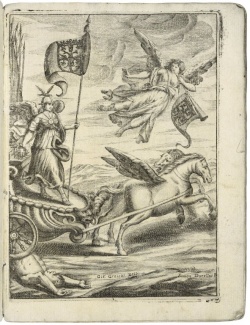
In Renaissance Italy, unlike England, women performed as actresses in the theater, and beginning in the later sixteenth century, they also wrote and published plays. Earlier Italian drama had been the purview of male writers, since the language was realistic and frequently bawdy. But as more refined romantic comedy became popular, the dramatic genre opened to women writers. Valeria Miani’s play, for example, is an early love story set in a refined pastoral setting. The later seventeenth-century dramas by Veronica Maleguzzi Valerii and Giulia Rangoni Ariberti continue the emphasis on virtue. More unusual was Margherita Costa’s earthy commedia del’arte drama, Li Buffoni.
Valeria Miani’s play, Amorous Hope, tells the story of a nymph, Venelia, who is abandoned by her husband and pursued by two shepherds. In the dedication to Marietta Uberti Descalzi, a gentlewoman from Miani’s hometown of Padua, the publisher writes that “some men will never give a fair reading to a book published by a woman.” However, pastoral drama, based on the writings of Tasso and Guarini, became a popular genre for female dramatists because sex could be dealt with under the mythical cover of nymphs and shepherds.
Another Italian playwright, Giulia Rangoni, wrote Virtue Triumphant, a three-act “royal opera” or masque dedicated to the Empress Eleonora Gonzaga, a great patron of the arts, to whom Rangoni was lady-in-waiting. The cast of characters from Crete, Cyprus, and Tunis reads like a Shakespearean romance, while the dramatic dialogue is interspersed at beginning, middle, and end with singing. Around 1675, Rangoni and her husband, the marchese Giovan Battista Ariberti, built a small theater in Cremona for private performances.
Also writing on virtue, the Contessa Malaguzzi was the well-educated daughter of a historic family in Reggio Emilia. She famously defended a Latin dissertation, but unable to find a paid court position based on her learning, she entered the Convent of the Visitation in Modena. In the foreword to Innocence Revealed, Malaguzzi explains that the play is based on a French story about Genevieve of Brabant. The virtuous tale is set in the Italian middle ages and, like Romeo and Juliet, deals with two feuding families. The play is dedicated to Laura Martinozzi, duchess of Modena.
Like many playwrights of the day, Roman-born Margherita Costa was also a singer and actress, and she spent time at the Medici court in Florence and at the French royal court. She wrote poetry, as well as a number of plays. Costa wrote her comedy Li Buffoni for the 1641 Carnival in Florence, dedicating it to her fellow actor, Bernadino Ricci. The illustration Li Buffoni: Comedia Ridicola shows the stage set and actors during the performance.
Items included
- Valeria Miani Negri. Amorosa speranza. Venezia: Per Francesco Bolzetta, 1604. 176- 173q, displayed title page.
- Giulia Rangone Ariberti. La virtù trionfante: opera regale. Milano: Per li heredi di Filippo Ghisolfi, 1690?. PQ4632.R15 V5 Cage; displayed frontis.
- Ottavio Bertotti Scamozzi. Il forestiere istruito delle cose più rare di architettura e di alcune pitture della città di Vicenza. Vicenza: Giovambattista Vendramini Mosca, 1761. NA1121.V7 B4 Cage; displayed foldout opposite p. 92.
- Margherita Costa. Li buffoni: comedia ridicola. Fiorenza: Nella stamp. nuoua d’Amador Massi, e Lor. Landi, 1641. 169- 572q; displayed frontis frontis illustration of stage.
- Veronica Maleguzzi. L’innocente riconosciuta: opera. Bologna: Per Giacomo Monti, 1660. 168- 227q; displayed p. 14-15.
Virginia Woolf Imagining Judith Shakespeare (wall between 10 and 11)
- FACSIMILE from private collection. George Charles Beresford. Virginia Woolf. Black and white photograph, 1902.
Literary Ladies as Playwrights (case 11)
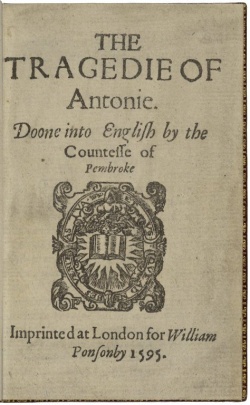
All of the women in this case were established literary figures from the upper classes for whom writing plays was another form of creative expression, meant to be shared primarily in private readings at home. Lady Mary Sidney and Viscountess Elizabeth Falkland drew on classical and biblical subjects through which they explored political and moral issues. Later in the century, Margaret Cavendish, duchess of Newcastle, wrote plays in a very personal style that explored the social roles of both women and men. She thought they might be performed, but preferred that they be read. And Katherine Philips was encouraged by the earl of Orrery to translate Pierre Corneille’s play on Pompey the Great, which was then acted in Dublin.
Mary Sidney’s translation of Robert Garnier’s French classical tragedy Marc Antoine marks the first time the story of Antony and Cleopatra was dramatized in England. It was intended as a closet-drama, a play to be read rather than acted. Although she followed the French closely, Sidney also based her work on Plutarch’s prose Life of Anthony. The Stoic philosophy of Garnier’s play foregrounds reason over emotion, which may have appealed to Sidney, as did Cleopatra’s verbal skill and knowledge of languages. It is likely that Shakespeare knew Sidney’s translation when he wrote Antony and Cleopatra around 1606.
Like Sidney, Elizabeth Cary’s closet history drama The Tragedie of Miriam takes the reader back to classical times. Written around 1605 and set in Judea under Roman rule, this play tells the story of Mariam, wife of the tyrant Herod. She is beautiful and chaste but also outspoken and is set against other female characters, such as Salome, who have been corrupted by the political system. Believing that Mariam has been unfaithful to him with his officer Sohemus, Herod has her put to death, but grievously mourns her afterwards. Scholars have noted similarities between the jealous-husband plot of Cary’s play and the plot of Shakespeare’s Othello, written around the same time. Cary’s Mariam is the first published original play by an English woman.
Better known today for her poems, Katherine Philips also translated two plays, including Pompey, a translation of Pierre Corneille’s La Mort de Pompée that she made while visiting Ireland. It was successfully performed at the Smock Alley Theatre in Dublin in February 1663. Conflicting political ideals are represented by two strong heroines, Cornelia and Cleopatra. The play cultivated French heroic drama, popular at the English court, and also served to identify and unite the diverse Anglo-Irish and English communities with whom Philips associated. Her plays and poems were so popular that they continued to circulate in manuscript even after appearing in print. On display were a 1678 printed edition and a manuscript edition copied out from an earlier printing.
Margaret Cavendish wrote poems, letters, fiction, and over a dozen plays. Her plays were written as conversations, and meant to be read in groups, rather than performed on stage. In them, Cavendish satirizes conventions of love, marriage, and the court, and examines many aspects of women’s lives and behavior. In her preface, Cavendish becomes the first Englishwoman to publish dramatic criticism. She praises Ben Jonson for his wit and classical learning, and Shakespeare for writing according to “Nature’s light.” Echoing the introductory poem to Shakespeare’s First Folio (1623) she writes:
I covet not a stately, cut, carv’d Tomb,
But that my Works, in Fames house may have room:
Thus I my poor built Cottage [her plays] am content,
When that I dye, may be my Monument.
When preparing this copy for exhibition, we were excited to find a hidden presentation inscription: “Mary [?last name] Her Booke Giuen by her Grace the Duches of Newcastle.” We know that Cavendish gave a number of her books as presents to friends, and also made corrections in the text, so this volume will provide new opportunities for research by scholars. More information about this discovery can be found at The Collation.
Items included
- Robert Garnier. The tragedie of Antonie. Doone into English by the Countesse of Pembroke. Translated by Mary Sidney, Countess of Pembroke. London: P. Short for William Ponsonby, 1595. STC 11623; displayed title page.
- Elizabeth Cary. The tragedie of Mariam. London: Thomas Creede for Richard Hawkins, 1613. STC 4613.2; displayed title page.
- Katherine Philips. Poems. London: T.N. for Henry Herringman, 1678. P2035; displayed frontis and title page.
- Katherine Philips. Copy of Poems by the most deservedly admired Mrs Katherine Philips, ca. 1670. V.b.231; displayed fol. 116.
- Margaret Cavendish, duchess of Newcastle. Plays, never before printed. London: A. Maxwell, 1668. N867; displayed title page.
English Women as Professional Playwrights (case 12)
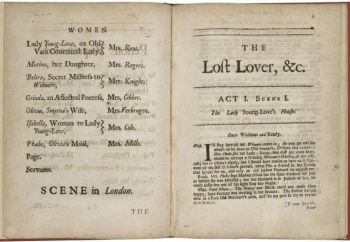
In London, on December 8, 1660 a woman performed the role of Desdemona in Othello. This was the first record of a professional actress on the English public stage. It followed the restoration of Charles II to the English throne, and was a result of influence from the French court where Charles had spent part of his exile. The new theater audience—more courtly and sophisticated than in Shakespeare’s time—was open to the innovation of actresses and to women writing for the public stage. Aphra Behn was the first female professional playwright, and she was soon followed by others, including Susanna Centlivre, Delarivière Manley, Mary Pix, and Catherine Trotter.
The well known Aphra Behn wrote novels, poetry, and nineteen plays that were performed on the stage. On display was The Widow Ranter, which tells the story of Bacon’s Rebellion in 1676, when Nathaniel Bacon commanded a force of Indians against the English governor of Virginia. It contains strong female roles, namely Semernia, the Indian Princess loved by Bacon, and the Widow Ranter, who dons men’s clothing to fight. Behn herself led an adventurous life, spending time in Surinam and serving as a government spy. In the mezzotint by William Vincent, the actress Anne Bracegirdle is depicted as Semernia in Aphra Behn’s The Widow Rante, a role she played when she was about eighteen.
Like Behn, Delarivière Manley led an interesting life, which reads at times like the plot of a play: well-educated but orphaned at an early age, forced into bigamy with her cousin, companion to Barbara Villiers (former mistress of Charles II), and finally a successful author. The Lost Lover is her first play, and contains two strong female roles, witty Olivia and the villainess Belira. Its poor reception led Manley to write: “I am now convinc’d Writing for the Stage is no way proper for a Woman” but she produced three more plays anyway.
Drawing on a plot from a 1688 novel by Aphra Behn, playwright Catharine Trotter produced Agnes de Castro when she was about sixteen years old. It draws on the story of a Portuguese prince, Don Pedro, who falls in love with a Spanish gentlewoman, Inês de Castro. Trotter published five plays, in each of which she included strong female characters.
Mary Pix arrived on the London literary scene at the same time as Catherine Trotter and Delarivière Manley, with whom she was friends. In the Prologue to The False Friend, Pix positions herself as a woman playwright:
Amongst Reformers of this Vitious Age,
Who think it Duty to refine the Stage:
A Woman, to Contribute, does Intend,
In Hopes a Moral Play your Lives will Mend.
Susanna Centlivre was one of the first Englishwomen to make the theater a true profession. She moved from acting to writing, producing sixteen plays. The Basset-table stars Lady Reveller, a young widow who earns extra money by hosting gambling at her home. Other colorful characters include Valeria, an intellectual who loves science, and Mrs. Sago, who “embezzles her husband’s stock.” The prim Lady Lucy sums up the difference between gambling and play-going: “one ruins my Estate and Character, the other diverts my Temper, and improves my Mind.” Because basset is a little-known card game today, the Folger Theatre retitled its 2012 production The Gaming Table .
Another poet-playwright was Anne Finch, regarded as the most important female British poet of her period. On display is the largest surviving manuscript of her works. It was transcribed by her husband Heneage Finch in a fair hand, but corrections by Anne in her crabbed writing are visible throughout. Finch served at the court of Mary of Modena, wife of James II, and composed fables, political poems, odes, and religious verse as well as plays. Both Jonathan Swift and Alexander Pope praised her poetry.
Items included
- Aphra Behn. The widdow ranter. London: Printed for James Knapton, 1690. B1774; displayed A4 (Dramatis Personae).
- William Vincent. The Indian queen. London: J. Smith ex., ca. 1689. ART 232- 569.1 (size XS) Image of ART 232-569 (size XS).
- Aphra Behn. Promissory note from Aphra Behn to Zachary Baggs. Autograph manuscript signed August 1, 1685. From Papers of Jacob Tonson. Manuscript, 1680-1737. C.c.1 (4) Image of C.c1.
- Mrs. Manley (Mary de la Rivière). The lost lover. London: printed for R. Bently, in Covent-Garden; F. Saunders, in the New-Exchange; J. Knapton, and R. Wellington, in St. Paul’s Church-Yard, 1696. M435; displayed p. 1.
- Catharine Trotter. Agnes de Castro, a tragedy. London: printed for H. Rhodes in Fleetstreet, R. Parker at the Royal-Exchange, S. Briscoe, at the corner of Charles-street, in Russel-street, Covent-Garden, 1696. C4801 copy 2; displayed title page.
- Susanna Centlivre. The basset-table. London: printed for Jonas Browne, and S. Chapman, 1706. 153- 587q; displayed frontis.
- Mary Pix. The false friend. London: Printed for Richard Basset, 1699. P2328 copy 2; displayed B1r.
Portrait of Anne Finch, Countess of Winchilsea (vitrine after case 12)
- Anne Kingsmill Finch, Countess of Winchilsea. Miscellany poems with two plays by Ardelia, ca. 1685-1702. N.b.3; displayed p. 141.
- FACSIMILE from National Portrait Gallery, London. Peter Cross. Portrait of Anne Finch, Countess of Winchilsea. Watercolor on vellum by Peter Cross, ca. 1690.
Learned Women (case 13)

English and European women of the Renaissance wrote in a variety of genres and on many subjects, as did their male contemporaries. Many of the writers featured in this case were considered to be the highest examples of learned women in their age. One of them, Elizabeth Jane Weston, was a muchrespected Neo-Latin poet among her European male peers. Many of these women were also interested in the improvement of their own sex through better education. Anna Maria van Schurman defended learning for women, while Hannah Woolley and Mary Astell wrote books setting out the skills they thought women should learn. Others such as Christine de Pisan and Lucrezia Marinella defended women against the many attacks from men in an ongoing battle known as the “quarrel of women.” At a time when most women had little education, these women were living examples of greater possibilities for their sex.
It might be said that Christine de Pisan was the first great female scholar in the European Renaissance to make a living through her writings. Reared at the French court of Charles V, she studied the classics, and, after her husband died, she supported herself and her children by writing. Her treatise The City of Ladies, written in French ca. 1404-05 presents the achievements of historical and contemporary women. “There is no man who could sum up the enormous benefits which have come about through women,” she writes, “and I proved this for you with the examples of the noble ladies who gave the sciences and arts to the world.” †
Pisan's desire that women be both educated and appreciated is echoed by the many women who wrote in the centuries after her. A poet and intellectual, Mary Astell was educated in philosophy and theology by her uncle. She felt strongly that women ought to receive a good education. “How can you be content to be in the World like Tulips in a Garden,” she asked, “to make a fine shew and be good for nothing?” A life of the mind, she writes in this book, is “a Matter infinitely more worthy your Debates, than what Colours are most agreeable, or what’s the Dress becomes you best?"
The German-Dutch scholar, religious leader, and artist Anna Maria van Schurman spent most of her life in the Netherlands, where she corresponded with a network of intellectual women across Europe. The Learned Maid is her most famous work, first published in Latin in 1641. Van Schurman argued that women who had the means and no family responsibilities should be able to study in all fields. She herself knew ten languages and was knowledgeable in history, theology, and astronomy, among other disciplines.
With knowledge of six languages, Bathsua Makin was known as the greatest female scholar in England, and she corresponded with fellow scholar Anna Maria van Schurman in the Netherlands. She became tutor to Princess Elizabeth, the daughter of Charles I, and this experience no doubt influenced her best-known work, the Education of Gentlewomen. She writes: “Were a competent number of Schools erected to Educate Ladyes ingenuously, methinks I see how asham’d Men would be of their Ignorance.” And she adds, “Had God intended Women onely as a finer sort of Cattle, he would have not made them reasonable.”
Hannah Woolley was a skilled medical practitioner and published books that included cooking and medicinal recipes as well as advice on household management. In her Guide she addresses all levels of women in the home from mistresses to maids, mixing advice on general behavior, love, and childbirth with recipes for preserved pears, pumpkin pie, and digestive remedies. She says that such a book covering the many facets of women’s lives “I have not met with in any language.”
Prolific Venetian poet Lucrezia Marinella also turned to a defense of her own sex in response to a vicious attack on women published by Giuseppe Passi in 1599. In Part I she praises women for their many virtues, and in Part II she condemns men for the same vices Passi had given to women. She writes: “My desire is to make this truth shine forth to everybody, that the female sex is nobler and more excellent than the male. I hope to demonstrate this with … examples, so that every man, no matter how stubborn, will be compelled to confirm it with his own mouth.” ††
- † (Translated by Earl Jeffrey Richards)
- †† (Translation by Anne Dunhill)
Items included
- Christine de Pisan. Here begynneth the boke of the cyte of ladyes. London: in Poules chyrchyarde at the sygne of the Trynyte by Henry Pepwell, 1521. STC 7271; displayed Aaii.
- Mary Astell. A serious proposal to the ladies, for the advancement of their true and greatest interest. London: Printed for R. Wilkin, 1694. 140- 765q; displayed title page.
- Anna Maria van Schurman. The learned maid. London: John Redmayne, 1659. S902; displayed frontis and title page.
- Abraham Bosse. La maistresse d’escole. Paris: Le Blond, ca. 1638. ART 264811 (size M) Image of Art 264811 (size M).
- Hannah Woolley. A guide to ladies, gentlewomen and maids. London: Dorman Newman, 1668. W3278.5; displayed frontis and title page.
- Elizabetha Johanna Westonia. Parthenicôn. Pragae: Pauli Sessij, 1606?. 152- 551q; displayed title page.
- Lucrezia Marinella. La nobilita, et l’eccellenza delle donne. Venetia: Appresso Gio. Battista Ciotti Sanese, 1601. 168- 763q; displayed title page.
- Bathsua Makin. An essay to revive the antient education of gentlewomen, in religion, manners, arts & tongues. London: John Darby, 1673. M309; displayed cover and title page.
Virginia and Vita Looking Back (case 14)
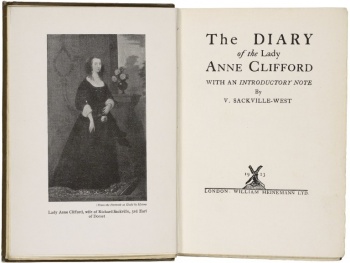
Virginia Woolf's A Room of One’s Own was a twentieth-century manifesto calling for women to be educated and to have literary careers. Although Woolf did not know of as many earlier women writers as we do now, she was fascinated by those she did know. She was also inspired by the life of her dear friend, Vita Sackville-West, to write her biographical novel Orlando. Sackville-West lived at Knole and was related to Lady Anne Clifford. She edited Clifford’s diary and wrote about her in a book on the history of Knole, in addition to writing biographies of other notable early modern women. Woolf, Sackville-West, and all the modern women writers who have followed, are descendants of those women to whom we have given “a room of their own” in this exhibition.
Lady Anne Clifford looms large in Vita Sackville-West’s biography of her ancestral home, Knole. Clifford was first married to Richard, earl of Dorset, one of Sackville-West’s ancestors, and her diary among the family papers provided Sackville-West with much information on the house and family in the period of James I. She sympathizes with Clifford, writing: “for my part I strongly suspect… her fighting spirit preferred even the ordeals and excitements of London to the tedium of Knole.”
In the last biography she wrote, Vita Sackville-West turned to the story of “La Grande Mademoiselle,” one of the wealthiest and most powerful women at the court of Louis XIV, and a woman whom we have noted for her Memoires. Sackville-West’s interest in her may stem from what she saw as Mademoiselle’s appreciation of her own sex. “She was intensely sensitive to feminine beauty, censorious when a woman was dowdily dressed, appreciative of grace and wit in their most feminine expressions. Yet she was no believer in a docile submission to man.”
A year after publishing the history of Knole in which Lady Anne Clifford figured so prominently, Vita Sackville-West brought out this edition of Clifford’s diary, which is based on an eighteenth-century transcript found in the papers at Knole. Sackville-West writes that Lady Anne “liked texts and maxims … and would make her secretary copy her favourites for her, which she would pin up inside the curtains of her bed, where her eye might conveniently light upon them.”
First published in London in 1927, Vita Sackville-West’s biography of Aphra Behn focuses mainly on Behn’s life, but the last chapter considers her as a writer. Sackville-West felt that Behn wasted her talents as a novelist. Instead of focusing on her own fascinating life in London, Behn drew on the European romance tradition. “Given her vigour and rapidity, her shameless candour and her knockabout experience, we should have had an earlier Defoe,” Sackville-West opines, but “as a playwright, … she did a trifle better…. That she opened the way for women as writers, is her principal claim on our gratitude.”
Items included
- LOAN from the Library of Congress. Virginia Woolf. A Room of One’s Own. New York: The Fountain Press, 1929. PN471 W6 1929a.
- V. Sackville-West. Knole and the Sackvilles. London: W. Heinemann, 1922. DA690.K7 S3; displayed title page.
- LOAN from the Library of Congress. Virginia Woolf. Orlando. London: L. and V. Woolf at the Hogarth Press, 1928. PR6045 O72 O7 1928b; displayed title page.
- V. Sackville-West. Daughter of France. London: M. Joseph, 1959. DC130.M8 S2; displayed title page with portrait.
- Anne Clifford Herbert, Countess of Pembroke. The diary of the Lady Anne Clifford, with an introductory note by V. Sackville-West. London: W. Heinemann ltd., 1923. DA378.P4 A3; displayed title page with portrait.